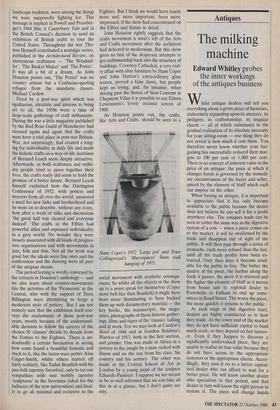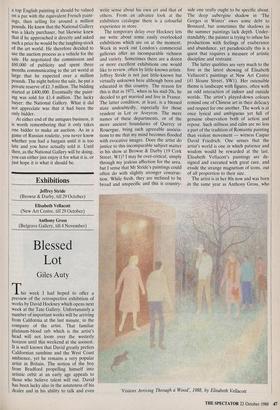Antiques
The milking machine
Edward Whitley probes the inner workings of the antiques business Whilst antique dealers will tell you everything about a given piece of furniture, elaborately expanding upon its ancestry, its pedigree, its craftsmanship, its singular charm — all of which culminates in the gradual realisation of its absolute necessity for your sitting-room — one thing they do not reveal is how much it cost them. You therefore never know whether your bar- gaining has successfully reduced their mar- gins to 100 per cent or 1,000 per cent. There is no concept of inherent value in the price of an antique: the price at which it changes hands is governed by the immedi- ate circumstances of the buyer and seller, spiced by the element of bluff which each can impose on the other.
When buying an antique, it is important to appreciate that it has only become available to the public because the dealer does not believe he can sell it for a profit anywhere else. The antiques trade can be seen in rather the same way as the digestive system of a cow — when a piece comes on to the market, it will be swallowed by the trade and disappear out of sight of the public. It will then pass through a series of stomachs, each more refined than the last, until all the trade profits have been ex- tracted. Only then does it become avail- able for the public to buy. The better the quality of the piece, the further along the trade it passes, the more it is restored and the higher the element of bluff as it moves from house sale to regional dealer to Portobello to Fulham to end up some- where in Bond Street. The worse the piece, the more quickly it returns to the public.
At each stage of this digestive tract, dealers are highly constricted as to how they trade. At the lower end of the market they do not have sufficient capital to fund much stock, so they depend on fast turnov- er. Even if they happen to discover a significantly undervalued piece, they are unable to realise its true value because they do not have access to the appropriate restorers or the appropriate clients. Accor- dingly, they pass it on to a better capital- ised dealer who can afford to wait for a better price. He will know another dealer who specialises in that period, and that dealer in turn will know the right person to restore it. The piece will change hands increasingly slowly and more expensively until it reaches its optimum price level.
Sitting at the most exalted end of the trade is Frank Berendt, a specialist in top quality 17th- and 18th-century French furn- iture. His shop, set across the road from Claridges, has the rarefied atmosphere of a museum. Each piece of furniture stands in its own space, spotlit from above, all of them spectacular examples of Louis XIV or XV craftsmanship. 'It is something of a . paradox,' he told me, tut the less I sell, the better off I am. In an ideal world, I would build up a perfect collection and never sell anything. I only have to replace anything I sell; it is increasingly difficult to find top quality pieces, and the prices are always going up. But' — he spreads his hands in a self-deprecatory gesture — 'I have to sell to pay the overheads!'
Although much of Berendt's business is related to funding a piece of furniture (each costing the price of a large house in Chelsea), he still has an instinctive flair for opportunity. 'I remember going for a walk around the block one afternoon. Things were quiet so I went to see what everyone else was up to. Just around the corner I saw a table in someone's window which I immediately recognised was by Andre- Charles Boulle. When I asked about it, I was told it was a 19th-century reproduc- tion. The dealer had bought it at Sothe- by's, who had mis-catalogued it as worth a couple of thousand pounds.' Berendt showed indifferent interest, mentioned that it was nice anyway and wandered off to look at other things. Once around the corner, he dashed back and despatched a cheque that afternoon. Six months later he sold' the table to the Paul Getty Museum. `Everyone has to hit the jackpot once in a while. I was lucky that I had the expertise to recognise it, know its true worth, and know who to sell it to. But in the end, that's what my customers pay for.'
Over the past 15 years, however, an increasing number of customers have chosen not to finance a dealer's mark-up and have started bidding directly at auc- tion. Berendt believes that these private collectors are misguided. 'Of course they have made some good purchases. But half of what they buy is not quite what it might
be — it could be mis-catalogued, or badly restored, or the bidding might have been chased up. There is no come-back from these auction houses — they do not have the responsibility which we have. If I sell a dud, my reputation suffers. Many top buyers have therefore missed the oppor- tunity to acquire a first-rate collection. They should have bought less, but been prepared to pay top prices for it.'
Although the auction houses present themselves as an open market where a public price is struck between a willing buyer and a willing seller, this is not all that it might seem. Both Sotheby's and Christ- ie's are anxious to raise the sale prices, in order both to bring more sellers into the market and secure higher commissions. They will offer free advertising, lower commissions and cash-down payments to the sellers (they might even purchase something themselves if it will set a record price); to the major buyers they offer interest-free credit. The prices are there- fore engineered upwards in a self-fulfilling and self-fuelling spiral.
The dealers also exploit the auction system in a number of ways. In the past they formed non-bidding rings, which en- abled them to pick up pieces cheaply, then hold their own private auction at a later date. This has been overtaken by the number of private collectors who bid against them. Now they find it more profitable to put a piece in a sale anony- mously, bid it up to a high premium and buy it back themselves. They can then put it in their shops and, with their hand on their heart, offer it to a buyer at just a modest premium over the 'proven' fair market value.
If a private collector feels bewildered in this hall of mirrors, he should seek profes- sional advice. Robert Holden is one of several antiques advisers who will negoti- ate for either a buyer or seller, and will call the bluff or simply bluff the other side. His most celebrated case was the sale of Charles Rogers Coltman's painting of his ancestors, 'Mr and Mrs Thomas Coltman Setting Out for a Ride', by Joseph Wright of Derby. Prior to this sale, Wright's pictures had never broached £70,000. Hol- den advised Rogers Coltman that as it was
a top English painting it should be valued on a par with the equivalent French paint- ings, then selling for around a million pounds. He knew that the National Gallery was a likely purchaser, but likewise knew that if he approached it directly and asked such a price he would be the laughing-stock of the art world. He therefore decided to use the auction process as a vehicle for the sale. He negotiated the commission and £60,000 of publicity and spent three months communicating to the art world at large that he expected over a million pounds. The night before the sale, he put a private reserve of £1.3 million, The bidding started at £400,000. Eventually the paint- ing was sold for £1.4 million. The lucky buyer: the National Gallery. What it did not appreciate was that it had been the only bidder.
At either end of the antiques business, it is worth remembering that it only takes one bidder to make an auction. As in a game of Russian roulette, you never know whether you had a bargain until it is too late and you have actually sold it. Until then, as the National Gallery will be doing, you can either just enjoy it for what it is, or just hope it is what it should be.




































































 Previous page
Previous page